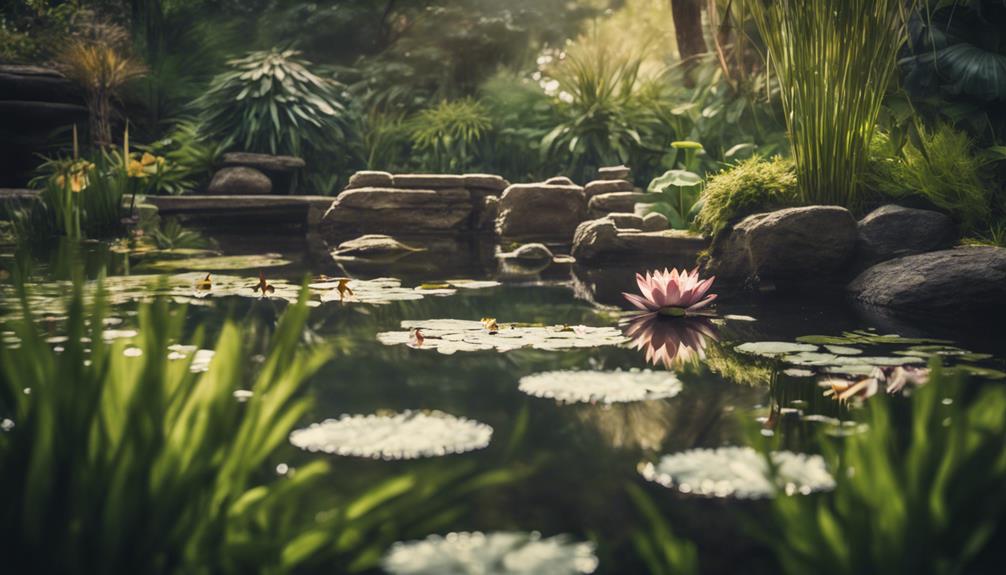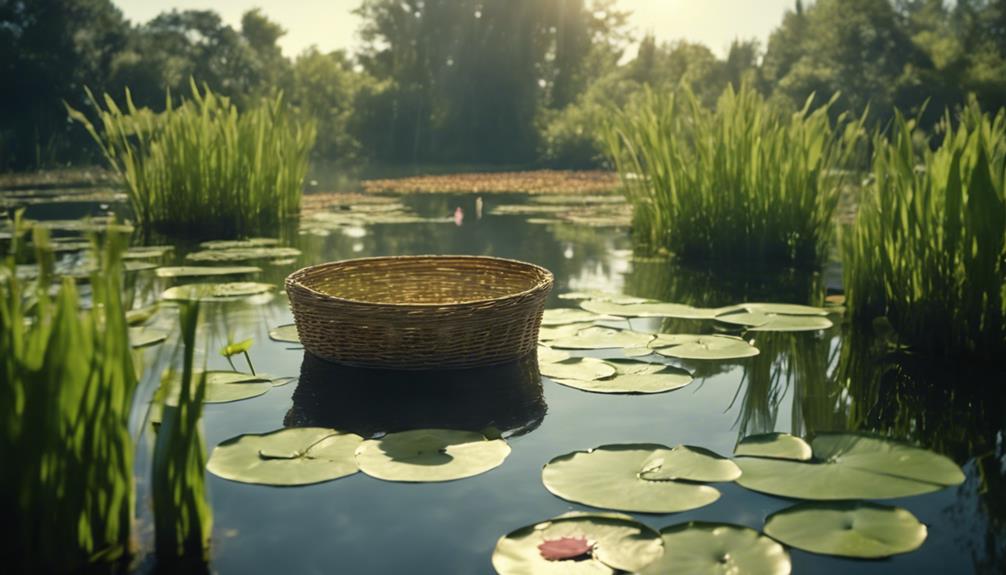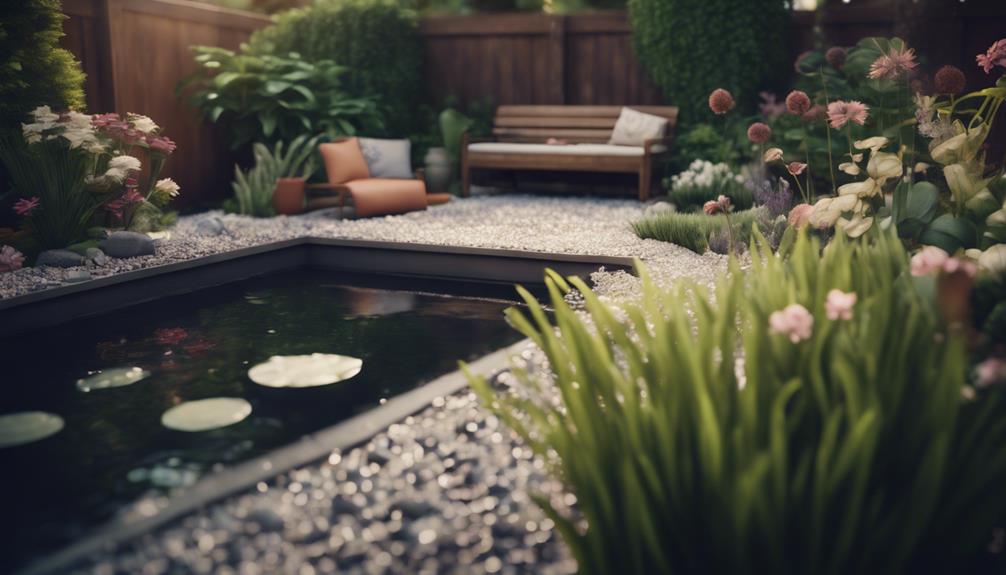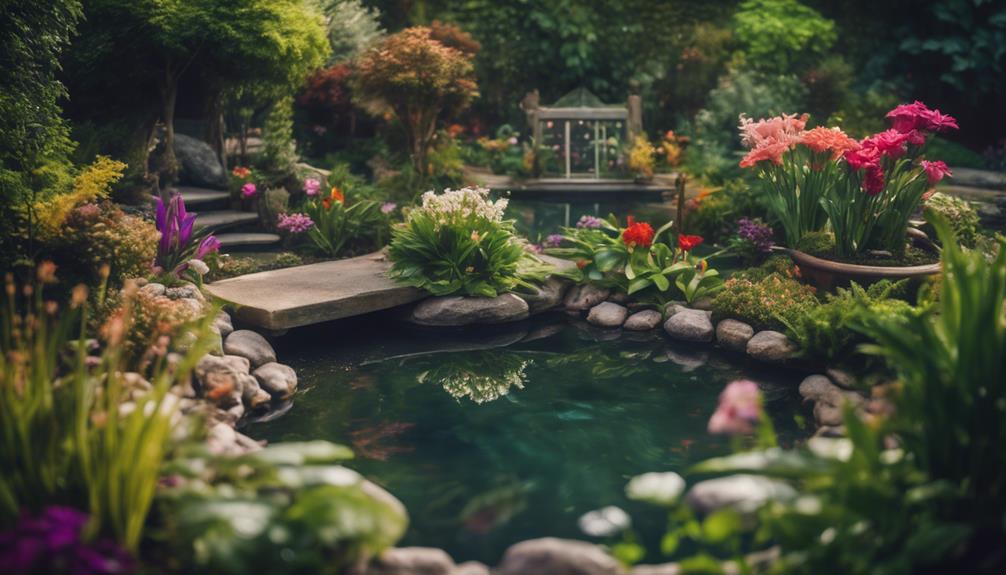You can naturally remove sediment from your garden water by harnessing the power of beneficial bacteria, aquatic plants, and natural methods like barley straw and plant-based coagulation agents. Beneficial bacteria break down organic matter, consuming excess nutrients and reducing sludge buildup. Aquatic plants like water lilies and cattails absorb nutrients, filter sediment, and provide habitat for beneficial microorganisms. Barley straw absorbs sediment, reducing cloudiness and algae growth. By combining these natural methods, you can maintain a healthy ecosystem and clear water. Now, discover the specific strategies to balance your garden water's ecosystem and keep it sediment-free.
Table of Contents
Key Takeaways
- Beneficial bacteria break down organic matter, consuming excess nutrients and removing sediment from garden water.
- Aquatic plants like water lilies, cattails, and hornwort absorb excess nutrients, reducing algae growth and filtering sediment from the water.
- Barley straw absorbs sediment from garden water, reducing cloudiness and algae growth, and can be applied in different ways for optimal results.
- Introducing beneficial microorganisms, such as probiotics, helps break down organic matter naturally, preventing sludge buildup and maintaining a healthy ecosystem.
- Plant-based coagulation agents, like moss, facilitate sediment settling, making it easier to remove sludge from garden water naturally.
Beneficial Bacteria in Action
As you introduce beneficial bacteria into your garden's ecosystem, they immediately get to work breaking down organic matter and consuming excess nutrients, effectively removing sediment from your garden water.
These microorganisms are incredibly efficient, converting complex compounds into simpler, more readily available nutrients for your plants.
In the process, they reduce the accumulation of sludge, which can choke your water features and clog your irrigation systems.
As beneficial bacteria multiply and thrive, they create a self-sustaining cycle of decomposition and nutrient cycling.
They're especially effective in areas with high levels of organic matter, such as ponds or water gardens with dense vegetation.
By introducing these beneficial microorganisms, you're creating a balanced ecosystem that's better equipped to handle excess nutrients and sediment.
This not only improves water quality but also reduces the need for harsh chemical treatments or manual removal methods.
Aquatic Plants for Sediment Control
Aquatic Plants for Sediment Control
By incorporating aquatic plants into your garden's water features, you're adding a natural, highly effective layer of sediment control that complements the beneficial bacteria's work. These plants play a vital role in maintaining a healthy pond ecosystem, and their benefits extend to sediment control. They absorb excess nutrients, reducing algae growth and preventing it from clouding your water.
| Plant Type | Benefits |
|---|---|
| Water Lilies | Shade the water, reducing algae growth and providing habitat for beneficial insects |
| Cattails | Absorb excess nutrients, and their roots help filter sediment from the water |
| Hornwort | Acts as a natural filter, trapping sediment and debris |
| Anacharis | Consumes excess nutrients, reducing algae growth and preventing sediment buildup |
Natural Methods for Sludge Removal

As you explore natural methods for sludge removal, you'll discover three effective approaches to examine.
You can utilize plant-based coagulation agents to facilitate sediment settling, implement strategies to manage algae blooms that contribute to sludge buildup, or harness the power of microbial decomposition processes to break down organic matter.
Plant-Based Coagulation Agents
When it comes to removing sediment from garden water, you can harness the power of plant-based coagulation agents, which offer a natural and effective approach to sludge removal.
These agents work by attracting and trapping sediment particles, making it easier to remove them from the water.
One such agent is moss, which can absorb and remove heavy metals like lead from water. Warnstofia fluitans moss, in particular, has been shown to remove arsenic from water at an impressive rate of 80% in under an hour.
Pine trees also have a natural filtration system that can remove bacteria from water, making them a potential plant-based coagulation agent.
Wetland plants like cattail and soft rush can remove heavy metals, bacteria, and other pollutants from water, making them effective natural coagulation agents.
Additionally, water mint has been shown to remove bacteria like E. coli and Salmonella from water, making it a natural coagulation agent for sediment removal in garden water.
Algae Blooms Management
Your garden pond's ecosystem can quickly spiral out of control if you don't address the issue of algae blooms, which not only cloud the water but also contribute to sludge buildup. Excess algae growth is a common problem in garden ponds, and managing it will prevent future issues.
Balance Nutrient Levels: Verify that your pond's nutrient levels are in check. Excess nutrients, such as phosphorus and nitrogen, can fuel algae growth. You can use natural methods like adding beneficial bacteria or plants that absorb excess nutrients.
Introduce Algae-Consuming Organisms: Introduce organisms that feed on algae, such as algae-eating fish, snails, or shrimp. These organisms will help control algae growth and prevent excess algae from accumulating.
Provide Adequate Aeration: Guarantee your pond has adequate aeration. Proper aeration helps to reduce stagnant water, which can contribute to algae growth. You can use natural methods like adding water features or installing a solar-powered aerator.
Microbial Decomposition Process
You can harness the power of microorganisms to break down sludge naturally, leveraging the microbial decomposition process to remove sediment from your garden water.
By adding beneficial bacteria to your water feature, you're providing the necessary tools for microorganisms to thrive and do their job.
These microorganisms will then begin the microbial decomposition process, effectively breaking down organic matter and decomposing organic sediment.
As the microbial decomposition process takes hold, you'll start to notice a significant reduction in sediment and sludge buildup.
This natural process not only removes sediment but also helps to maintain a healthy balance of microorganisms in your garden water.
Probiotics for Pond Sludge Removal
By introducing beneficial microorganisms into your pond's ecosystem, probiotics effectively break down organic matter, reducing sediment accumulation and promoting a healthier environment.
This natural approach helps remove leaves and sludge from the bottom of your pond, creating a more balanced and thriving ecosystem.
Enhanced decomposition: Probiotics accelerate the breakdown of organic matter, reducing the accumulation of sediment and sludge.
Improved water quality: By breaking down organic compounds, probiotics help reduce nitrogen and phosphorus levels, leading to clearer and healthier water.
Increased oxygen levels: As probiotics consume organic matter, they release oxygen, which benefits aquatic life and promotes a more balanced ecosystem.
Barley Straw for Sediment Absorption

As you consider using barley straw for sediment absorption in your garden water, you'll want to think about how to apply it effectively and how quickly it can start making a difference.
You'll need to decide on the best straw application method for your specific situation, whether that's adding it to the water's surface or using a submerged bag.
Straw Application Methods
Barley straw, a natural and effective sediment-absorbing agent, can be applied to garden water in several ways to maximize its sediment-removing potential.
As you explore the best methods for your garden, consider the following application techniques:
Bottom of your pond: Place a bale of barley straw at the bottom of your pond to absorb sediment and debris. This method is especially effective for controlling algae growth and reducing water cloudiness.
Floating straw: Suspend a bale of barley straw just beneath the water's surface using a float or a weighted rope. This allows the straw to absorb sediment and debris without getting stuck in the mud.
Straw bundles: Tie small bundles of barley straw with twine and submerge them in your garden water. This method allows for easy removal and replacement of the straw when it becomes saturated with sediment.
Remember to replace your barley straw every 2-3 months to maintain its effectiveness. Also, be sure to remove any leaves or debris that may accumulate on the surface of the water, as they can reduce the straw's absorbency.
Sediment Absorption Rate
Barley straw absorbs sediment from garden water at a rate of 1-2 pounds of sediment per 10 pounds of barley straw per month, depending on various factors.
The sediment absorption rate can be influenced by factors such as water flow rate, pH, and temperature. Ideal absorption occurs at a pH range of 6-8 and temperatures between 50-70°F.
In a study, barley straw was found to remove 60-80% of suspended solids and 40-60% of turbidity from water in just 24 hours. This impressive sediment removal is attributed to the release of lignin, a complex organic compound that binds to sediment particles, making it an effective natural filtration method.
Preventing Sludge Buildup Naturally
Regularly introducing beneficial microorganisms into your garden water system helps prevent sludge buildup by breaking down organic matter naturally. This approach not only helps to reduce the accumulation of sediment at the bottom of the pond but also maintains a healthy environment for your aquatic plants and animals.
Three ways to prevent sludge buildup naturally:
- Add beneficial bacteria: Introduce bacteria that feed on organic matter, breaking it down into harmless compounds that won't contribute to sludge buildup.
- Use natural clarifiers: Certain plants, like water hyacinth or duckweed, help to clarify the water and absorb excess nutrients that can contribute to sludge formation.
- Maintain good water circulation: Guarantee that your pond's water is circulating properly to prevent stagnation, which can lead to sludge buildup.
Maintaining a Healthy Pond Ecosystem

By maintaining a healthy pond ecosystem, you'll create an environment where beneficial bacteria can thrive, breaking down organic matter and preventing the accumulation of sediment.
This is vital, as pond sludge can lead to low oxygen levels, causing fish and other aquatic creatures to suffocate and die.
Regularly testing the water can help identify imbalances in pH levels, oxygen levels, or nutrient levels, allowing you to take corrective action.
Adding beneficial bacteria to the pond can help break down organic matter and maintain a healthy ecosystem.
Probiotics, beneficial bacteria, and enzymes can also be used to break down organic matter in pond sludge, releasing nutrients into the water and reducing the overgrowth of algae and other aquatic plants.
By taking these steps, you'll create a thriving ecosystem where your fish and plants can flourish.
Plants That Filter Water Naturally
As you aim to maintain a healthy pond ecosystem, you're probably wondering how to keep your garden water clean and clear.
Certain aquatic plants, such as hornwort and water wisteria, have natural filtering properties that help remove sediment and excess nutrients from garden water, effectively clarifying it.
By incorporating these plants into your pond, you'll be able to enjoy a more balanced and thriving ecosystem.
Reduced sedimentation: Plants help remove leaves and other debris from the water, preventing sediment from building up at the bottom of your pond.
Improved water quality: By absorbing excess nutrients, these plants prevent the growth of algae and keep your pond water clean and clear.
Enhanced biodiversity: A healthy pond ecosystem supports a diverse range of aquatic life, from fish to beneficial bacteria, which in turn help to break down organic matter and maintain a balanced environment.
DIY Water Garden for Sediment Control

You can create a DIY water garden in your backyard to naturally filter water and control sediment using a variety of plants that absorb pollutants and oxygenate the water.
By incorporating plants like water lilies, irises, cabomba, and hornwort, you can create a self-sustaining ecosystem that improves water quality.
A whiskey barrel pond is a great option for a DIY water garden, providing a compact space for your plants to thrive.
To maintain your DIY water garden, you'll need to regularly add oxygenating plants, control algae growth, and maintain proper water circulation.
This will keep your water clean and clear, reducing the need for a pond vacuum and preventing sludge from building up on the bottom.
By taking care of your DIY water garden, you'll be able to enjoy improved water quality and a beautiful, thriving ecosystem.
With the right plants and maintenance, you can create a natural and effective way to remove sediment from your garden water.
Natural Pond Sludge Removal Methods
As you explore natural pond sludge removal methods, you'll find that plant-based solutions can be highly effective.
You'll discover how certain aquatic plants can absorb excess nutrients, reducing sludge buildup, and how barley straw can inhibit algae growth, leading to a cleaner pond ecosystem.
Plant-Based Sludge Control
By incorporating specific aquatic plants into your pond's ecosystem, you can harness their natural ability to absorb excess nutrients, thereby reducing sludge accumulation. This plant-based sludge control method is an effective and eco-friendly way to maintain a healthy pond environment.
Aquatic plants like water lilies, cattails, and duckweed help remove excess nutrients from the water, making the water clearer and reducing the risk of sludge buildup.
Nutrient absorption: Aquatic plants absorb excess nutrients like nitrogen and phosphorus, reducing the amount of nutrients available for algae growth, which contributes to sludge formation.
Oxygen production: During photosynthesis, aquatic plants produce oxygen, which helps to break down organic matter and reduce sludge accumulation.
Habitat creation: Aquatic plants provide a habitat for beneficial microorganisms, which help to break down organic matter and reduce sludge.
Barley Straw Benefits
In addition to aquatic plants, another natural and effective method for removing sediment from garden water is the use of barley straw, which has been shown to inhibit algae growth and reduce sludge accumulation.
As you introduce barley straw into your pond, it starts to break down and release compounds that prevent algae from growing. This, in turn, reduces the amount of sediment that settles at the bottom of your pond.
When you combine barley straw with a Pond Pump, you'll notice a significant reduction in sludge buildup. The pump helps to circulate the water, allowing the barley straw to work more efficiently.
As a result, your body of water will remain clear and healthy. By using barley straw, you'll not only remove sediment but also create a balanced ecosystem.
This natural method is a great alternative to chemical treatments and is safe for your plants and aquatic life. By incorporating barley straw into your pond maintenance routine, you'll enjoy a cleaner and more sustainable garden water feature.
Frequently Asked Questions
How to Get Rid of Pond Sludge Naturally?
You can tackle pond sludge naturally by introducing sludge eaters like beneficial microbes, which break down organic matter, or using natural clarifiers like barley straw to release chemicals that combat sludge buildup.
How Do I Make My Pond Water Clear Naturally?
You can achieve clear pond water naturally by implementing effective aeration techniques, boosting water circulation, and increasing sunlight exposure, which will help break down organic matter and promote a healthy ecosystem, making your pond sparkle.
How to Remove Silt From Pond Diy?
"An ounce of prevention is worth a pound of cure." You can DIY remove silt from your pond by installing pond filters, silt traps, and improving water circulation, which will help prevent sediment buildup and keep your pond water clear and healthy.
What Plant Cleans Water?
You're curious about plants that clean water! Water Hyacinth, an aquatic plant, excels at absorbing excess nutrients and pollutants. As a flood-tolerant species, it's perfect for ponds and water features, helping you maintain a healthy, thriving ecosystem.
Conclusion
As you gaze into the depths of your pond, the water's clarity is a reflection to the harmony of nature.
Beneath the surface, a subtle dance is unfolding. Beneficial bacteria feast on organic matter, aquatic plants absorb excess nutrients, and probiotics break down sludge.
Barley straw sponges up impurities, while plants like cattails and water lilies filter the water with precision.
Your pond's ecosystem is thriving, and with these natural methods, the sediment is slowly disappearing, revealing a crystal-clear haven, teeming with life.

